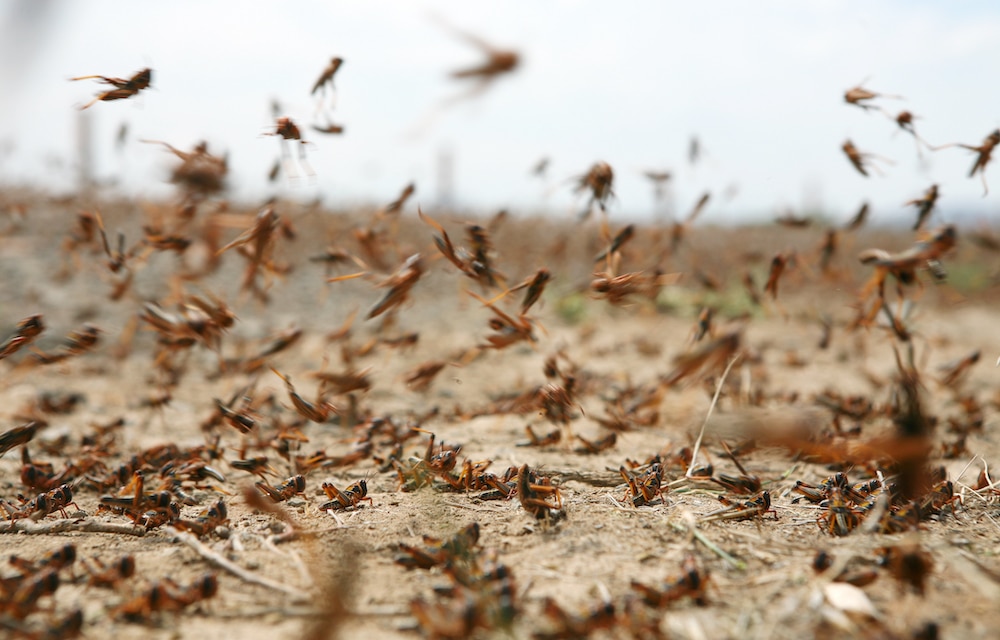Create a free profile to get unlimited access to exclusive videos, sweepstakes, and more!
Grasshopper’s get hangry! Gut bacteria to blame for locusts swarming
Has anyone offered the swarm a Snickers?

The thought of locusts swarming through an area in a vast, ravenous swarm conjures images of biblical plagues and ancient curses. It’s a reasonable response. Locusts have been a pest animal since the time of antiquity. They decimate crops and have been reported to eat the clothes right off a person’s body as they migrate over an area. Swarms can number in the trillions and cause enough damage to rival a natural disaster.
With all of that in mind, you’d be forgiven for thinking locusts are some ungodly creatures which emerge from the dark recesses of the world to punish us for our sins, but they’re way more ordinary than that. You’ve probably seen them hopping around the garden in the summertime.
Locusts begin life as everyday grasshoppers. They live mostly on the ground eating various leaves, flowers, and seeds. They are capable of flight, but only over short distances. And they live mostly alone, actively avoiding contact with other grasshoppers. Few people encounter a grasshopper and see a monster, but things change when they congregate in groups.
It’s well understood that when some species of grasshopper — about 10 out of the 8,000 total species — get together in large numbers, they undergo physiological and behavioral changes, turning them into something which appears and acts like a different animal altogether.
Within hours of joining a group, grasshoppers-turned-locust, change their coloration, they become larger and stronger, and they start seeking out other locusts to form a swarm. What’s less clear is what’s happening inside the body to force this incredible change.
Scientists at Tel Aviv University think they might have at least part of the answer. They carried out a recent study published in the journal Environmental Microbiology. The team looked at the microbiome — the colonies of bacteria in the gut — of individual locusts in the lab, before and after transitioning into swarming mode.
They found a significant change in the composition of gut bacteria during the transition from solitary to gregarious, specifically as it relates to a particular bacteria called Weissella.
When locusts are solitary, Weissella makes up only a very small part of the total bacteria in the microbiome. Once they get into to groups of about 200 or more, however, the distribution changes. It’s almost as if the Weissella bacteria is mirroring what the locusts are doing, only on a microscopic scale.
Soon, Weissella becomes the dominant microbial force. Scientists were careful to state this isn’t unequivocal evidence that Weissella is responsible for the change in behavior, but the relationship between the microbiome and the behavior is becoming increasingly well known, and the correlation is striking.
The team also ran mathematical models which showed the swarming behavior of locusts might be beneficial for the bacteria. The change in behavior puts individuals into much closer proximity with a large number of individuals, making it easier for the bacteria to spread. If the hypothesis is borne out, it would mean that Weissella is acting selfishly, forcing a change in their host in order to propagate throughout the larger population.
Today, when locust swarms form, they’re incredibly difficult to stop. All of the offspring born during the swarming phase are themselves necessarily swarmers. There’s a feedback loop which reinforces itself and often doesn’t stop until the locusts have consumed everything available, or until pesticides are used to kill the swarm.
The Tel Aviv study suggests that even if Weissella bacteria isn’t the primary cause of swarm formation in locusts, it at least plays a significant role. A better understanding of what’s happening inside each individual insect’s body could provide new strategies for breaking up swarms before they become devastatingly destructive.


























